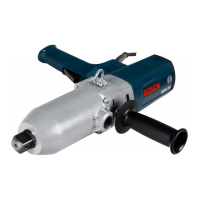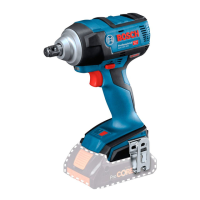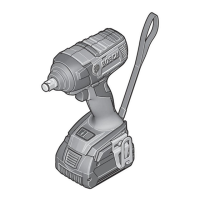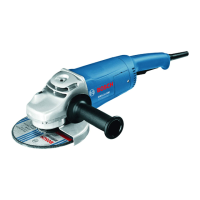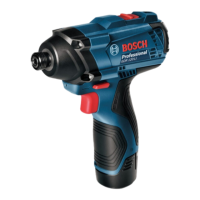6 | English
3 609 929 D01 | (7.3.14) Bosch Power Tools
Assembly
Changing the Tool
Before any work on the machine itself, pull the mains
plug.
When working with an application tool, pay attention
that the application tool is firmly seated on the tool
holder. When the application tool is not firmly connected
with the tool holder, it can come loose again and not be
controlled.
Slide the application tool 7 onto the square drive of the tool
holder 6.
Operation
Method of Operation
The tool holder 6 with the tool is driven by an electric motor
via a gear and impact mechanism.
The working procedure is divided into two phases:
Screwing in and tightening (impact mechanism in action).
The impact mechanism is activated as soon as the screwed
connection runs tight and thus load is put on the motor. In this
instance, the impact mechanism converts the power of the
motor to steady rotary impacts. When loosening screws or
nuts, the process is reversed.
Starting Operation
Observe correct mains voltage! The voltage of the pow-
er source must agree with the voltage specified on the
nameplate of the machine. Power tools marked with
230 V can also be operated with 220 V.
Reversing the rotational direction
Actuate the rotational direction switch 5 only when the
machine is at a standstill.
The rotational direction switch 5 is used to reverse the rota-
tional direction of the machine.
Right rotation: Press the rotational direction switch 5 down-
ward to the stop (R).
Left rotation: Press the rotational direction switch 5 upward
to the stop (L).
Switching On and Off
To start the machine, press the On/Off switch 5 and keep it
pressed.
To switch off the machine, release the On/Off switch 5.
To save energy, only switch the power tool on when using it.
Working Advice
Before any work on the machine itself, pull the mains
plug.
Operate your machine only with the auxiliary handle 2.
Apply the power tool to the screw/nut only when it is
switched off. Rotating tool inserts can slip off.
The torque depends on the impact duration. The maximum
achieved torque results from the sum of all individual torques
achieved through impact. The maximum torque is achieved
after an impact duration of 6-10 seconds. After this duration,
the tightening torque is increased only minimally.
However, the transmission housing heats up noticeably.
Note: The consequences of excessive heating-up are high
wear of all hammer mechanism components and a high re-
quirement of lubricant.
The impact duration is to be determined for each required
tightening torque. The actually achieved tightening torque is
always to be checked with a torque wrench.
Screw Applications with Hard, Spring-loaded or Soft Seat
When in a test, the achieved torques in an impact series are
measured and transferred into a diagram, resulting in the
curve of a torque characteristic. The height of the curve corre-
sponds with the maximum reachable torque, and the steep-
ness indicates the duration in which this is achieved.
A torque gradient depends on the following factors:
– Strength properties of the screws/nuts
– Type of backing (washer, disc spring, seal)
– Strength properties of the material being screwed/bolted
together
– Lubrication conditions at the screw/bolt connection
The following application cases result accordingly:
–A hard seat is given for metal-to-metal screw applications
with the use of washers. After a relatively short impact du-
ration, the maximum torque is reached (steep characteris-
tic curve). Unnecessary long impact duration only causes
damage to the machine.
–A spring-loaded seat is given for metal-to-metal screw ap-
plications, however with the use of spring washers, disc
springs, studs or screws/nuts with conical seat as well as
when using extensions.
–A soft seat is given for screw applications, e. g., metal on
wood or when using lead washers or fibre washers as back-
ing.
For a spring-loaded seat as well as for a soft seat, the maxi-
mum tightening torque is lower than for a hard seat. Also, a
clearly longer impact duration is required.
Max. screw dia.
M 24 M 30
Tool holder
¾" 1"
Weight according to EPTA-Procedure 01/2003
kg 5.7 7.3
Protection class
/ II / II
Impact Wrench GDS 24 GDS 30
The values given are valid for a nominal voltage [U] of 230 V. For different voltages and models for specific countries, these values can vary.
OBJ_BUCH-550-002.book Page 6 Friday, March 7, 2014 1:03 PM
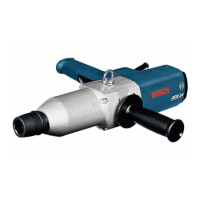
